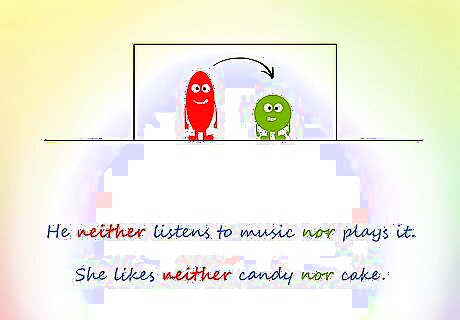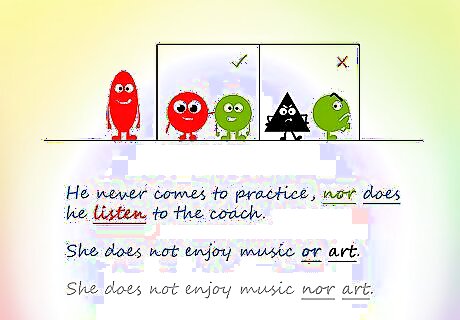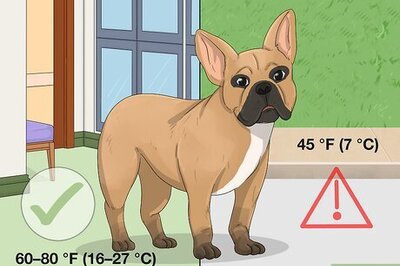
views
Using "Nor" with "Neither"

Follow "neither" with "nor" within a sentence. Usually, "nor" follows "neither" in the same sentence, as in, "neither A nor B." Together, this neither/nor structure forms something known as a correlative pair. This means that the information one term introduces is connected or related to the information the other term introduces. The two terms can be applied when discussing actions or they can be used when listing nouns. For instance, "He neither listens to music nor plays it," or "Alex likes neither candy nor cake." "Neither” can also start a sentence. As an example, “Neither Sarah nor Jim can make it to the party on Saturday.” On the other hand, either/or shows when something does occur. For example, "Alex wants either candy or cake." Notice how this sentence tells us that Alex likes both of these things and will eat either, where as the neither/nor sentence told us that Alex doesn't like both of them.

Use “nor” multiple times within a list. Typically, the neither/nor structure is only used when drawing a negative connection between two objects or actions. You can use "nor" when talking about more than two ideas, though, but you need to repeat the word "nor" after each item in your list. Note that "neither" is only used once, no matter how many times you use "nor." Do not merely separate the items in your list by commas. Correct example: "The store had neither peanut butter nor jelly nor bread. Incorrect example: "The store had neither peanut butter, jelly, nor bread."

Keep your "neither" and "nor" parallel. Parallel structure, as it applies to the neither/nor form, means that both halves of phrase need to match each other in regards to the information being described. In other words, you cannot follow "neither" with a verb action and "nor" with a noun, or vice versa. Both most either introduce a verb or introduce a noun. Correct example: "We saw neither Gwen nor Eric during our trip. Correct example: "We neither saw Gwen nor spoke to Eric during our trip." Incorrect example: "We neither saw Gwen nor Eric during our trip."

Do not use "nor" with "either." The terms “either” and “neither” are used in similar manners, but “either” is positive while “neither” is negative. As such, you must pair the negative “neither” with the negative “nor” and the positive “either” with the positive “or.” Just as “neither” is always paired with “nor,” “either” is always paired with “or.” Correct example: "Neither James nor Rebecca is interested in basketball.” Correct example: "Either eat your vegetables or skip your dessert.” Incorrect example: “I neither know the rules of the game or care to know.” Incorrect example: “I will either go to the library or take a nap.”
Using "Nor" Without "Neither"

Use "nor" with other negatives. Even though "nor" is almost always used after "neither," you can use it with other negative expressions and still form something grammatically correct. As an example, "The final guest is not here, nor should we wait for her before we start the festivities," or "He has never gone fishing, nor does he have any desire to learn."

Stick to one “nor” if you're using it outside of its correlative pair. When listing more than two objects or actions, separate each item in the list by a comma and precede the final one with “nor.” Do not introduce each separate item in the list with “nor.” Compare this to the use of “nor” within its correlative neither/nor pair. When used with “neither,” you must say “nor” before each item in a list. When used without “neither,” you should only use “nor” once. Correct example: He has never experienced joy, sadness, nor anger with such passion before.” Incorrect example: He has never experienced joy nor sadness nor anger with such passion before.”

Opt for “nor” if your negative thought includes a verb phrase. There are times when a negative mood in a sentence should be followed through with "or" instead of "nor." If the second part of the negative is a verb phrase—an action—then "nor" is correct. If the second part of the negative is a noun, adjective, or adverb phrase, however, the initial negative will be carried through the rest of the sentence, making "nor" redundant. In these instances, "or" should be used, instead. Correct example: "He never comes to practice, nor does he listen to the coach." Correct example: "She does not enjoy music or art." Incorrect example: "She does not enjoy music nor art."

Be careful when using "nor" alone. As a negative conjunction, "nor" is almost always used to connect two thoughts or items in a sentence that has an established negative tense. You can technically use "nor" without using any other negative term, but this is very rarely done. Using "nor" on its own will usually seem stiff and unnatural. Since it is so rare, many will also think that you are using "nor" improperly. Even though there is no negative element within the sentence, you still need to make sure that the idea expressed after "nor" connects to the idea described before it in a sensible manner. Example: "The report was done on time, nor does it appear to contain any mistakes."
Following Grammar Rules

Match your verb tense to your noun tense. A singular noun requires a singular verb, while a plural noun requires a plural verb. Otherwise, they won't be in agreement. For example, "Neither Marie nor Jorge is going to the movies," or "Neither cats nor dogs are allowed at the hotel."

Look at only the second noun if the tenses are mixed. Sometimes you will have a singular verb paired with a plural verb in the same sequence. Look at the noun closest to the verb (usually the noun following "nor") to determine the tense. If this noun is plural, make your verb plural. If it is singular, make the verb singular. If you're in doubt, read the just the second noun and the verb aloud to see if it sounds right. Incorrect example: "Neither they nor he are interested." Correct example: "Neither they nor he is interested." Incorrect example: "Neither he nor they is interested." Correct example: "Neither he nor they are interested."

Use a comma when "nor" sets off an independent clause. When “nor” sets off a dependent clause, no comma is necessary. Similarly, a comma is not necessary if “nor” is only used to draw a relationship between two nouns. If it sets off an independent clause, however, you should proceed the “nor” with a comma. A dependent clause is a sentence fragment that relies on the rest of the sentence to be complete. An independent clause contains both a subject and a verb, and as a result, it could be separated from the rest of the sentence and still stand on its own. Correct example: “No one knew the answer, nor did they make a guess.” Incorrect example: “No one knew the answer nor did they make a guess.”
















Comments
0 comment